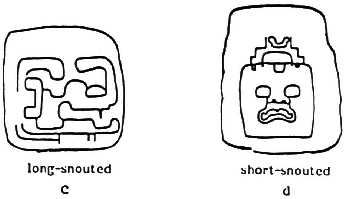|
The only difference, besides that of style, is that at Cerros a long and short-snouted mask are paired and placed on either side of the staircase and at Tzutzuculi the long-snouted mask (figure 1c) is placed on the right and the short-snouted mask (figure 1d) on the left side of the staircase.
The Late Formative Period Maya were manipulating long-snouted and blunt-snouted architectural masks for religious and political purposes. The erection of such masks on a similar structure 550 years earlier at Tzutzuculi implies that the origins of such paired oppositions and the artistic canon by which they were manipulated is found in the art styles of the Middle Formative Period. In order to test this hypothesis, other examples of Olmec and Middle Formative Period art depicting paired oppositional iconography should be scrutinized for their political implications. Information gained from such an analysis will shed light not only on Olmec iconographic usage and political structure but on the specifics of the iconography and political structure of the classic Maya as well.
|
